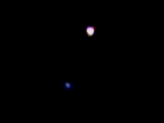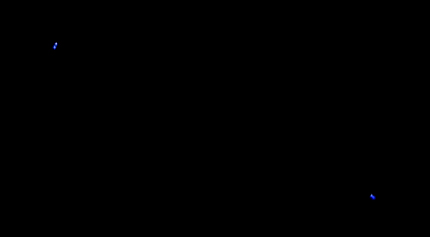Castor - Alpha Geminorum - 2005.02.24.
20:11UT, Seeing 3/10, Transp.3/10
Celestron C9.25XLT, Meade 2x Barlow
ToUcam Pro, nonraw-optimized mode
491 frames stacked
Scope obviously not collimated 100% (see diffraction-ring pattern)
Castor, blue-white system in Gemini. Castor consists of components A
with a magnitude of 2.0 and B with magnitude 2.9. Since A and B revolve
about each other ~every 450 years the apparent distance changes, about
4" when the above image has been captured. There's another faint
component C with variable mag ~9.4 and 72.5" distance.
Epilon Lyrae 2004.11.03.

The 'double double' in Lyrae consisting of four stars. The pairs A/B
and C/D are 208" apart. A and B are about 2.6" apart, C and
D are separated by about 2.3".Components C and D have about the same
magnitude: 5.1 (C) and 5.5 (D). A and B differ more in magnitude: 4.7
(A) and 6.2 (B).
Epsilon Lyrae's distance to earth is 162 light-years. It's not just a
visual double double system: A and B orbit each other with a period of
1200 years, C and D with a period of 585 years. The two pairs orbit each
other within a distance of 0.16 light-years taking several hundred thousand
years.
Epilon Lyrae 2004.10.11.

2004.10.11, 19:59UT, Seeing ~2/10
Vixen VMC200L, ToUcam 740 pro in prime focus
200frames stacked

Albiero in the Cygnus constellation has a beautifull color contrast between it's two components. BET1 (~3mag) shows a bright orange and BET2 (~5mag) a deep blue. I could not resist to insert the webcam into the focusser tube during some star tests and collimations of my Mak-Newton :)

Albiero - Beta Cygni

